You are here
Home 🌿 Recreational Marijuana News 🌿 Art ablaze: Once criminalized for their craft, marijuana pipemakers are now celebrated 🌿Art ablaze: Once criminalized for their craft, marijuana pipemakers are now celebrated

Chris Vela dances with fire as he twirls molten glass over a glowing flame. He likens the mesmerizing effects to a campfire – a hypnotic incandescence.
As a contemporary marijuana glass artist, Vela makes translucent electric green bubblers and glistening salmon pink Sherlock pipes. He has hollow-sculpted a real-life horned lizard skull – a blazing orange piece ultimately affixed to a bong of the same color.
Artists making marijuana glass, or "heady glass," and other smoking devices are now stepping out of the shadows: garnering masses of followers on Instagram – the "yellow pages" of cannabis – and selling top-tier pieces for thousands of dollars. The art of glassblowing, an ancient trade going back to 1st century BC, got its own spotlight on a popular 2019 Netflix show called "Blown Away."
Vela lives in Beverly, Massachusetts, and is the curator for "Art of Glass," a project by Allston-based marijuana packaging company Catalyx Containers, showcasing these artists and their work as "true cultural artifacts of cannabis."
But just two decades ago, the U.S. Department of Justice considered the craft criminal.
In 2003, as the DOJ announced indictments stemming from code-named "Operation Pipe Dreams," officials called the makers and sellers of marijuana pipes "criminals" who would "poison our children."
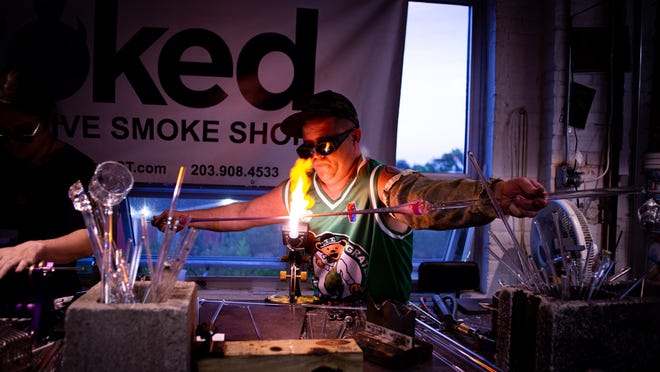
"People selling drug paraphernalia are in essence no different than drug dealers," John Brown, acting administrator of the Drug Enforcement Administration, said at the time.
Before moving to the East Coast, Vela had worked in a northern California pipe shop that was raided by law enforcement during Operation Pipe Dreams.
"I've seen the whole evolution of it, and I've had a lot of friends go to jail for this, their whole life's work taken out from underneath them," he said. "To now, where it's so mainstream and in the limelight."
Recreational marijuana has now been legalized in 18 states and the District of Columbia. Twenty-seven states and territories have decriminalized marijuana –– meaning small, personal-consumption amounts are a civil or local infraction, not a crime with potential jail time.
Though still illegal federally, national marijuana sales are expected to hit $24 billion this year. In New England, Massachusetts, Vermont, Maine and Connecticut have legalized recreational use and sales, while Rhode Island is also on track, potentially as early as this fall.
As a result, the marijuana art scene has experienced newfound recognition that's been years in the making.
"To me, it's night and day from what it was," said Vela, who sells under the name "Vela G." "It used to be really taboo, and you had to know someone who knew someone to get a piece."
Tito Bern has been blowing glass since 1999, and was selling his creations to pipe shops right around the time Operation Pipe Dreams made national headlines. Today, he's the co-founder of The Bern Gallery in Burlington, Vermont, an award-winning smoke and glass shop that hosted the world's first pipe-making classic in 2006.
"I felt like glass pipes chose me, almost like I didn't really have a choice in the matter," he said. To Bern, marijuana glass is an "absolutely incredible art," where artists "use the pipe as a canvas" while also considering technical aspects such as function and usability.
Bern's shop sells pieces that can reach upwards of $4,500 – and the ones they auction off after each year's pipe classic can get $10,000.
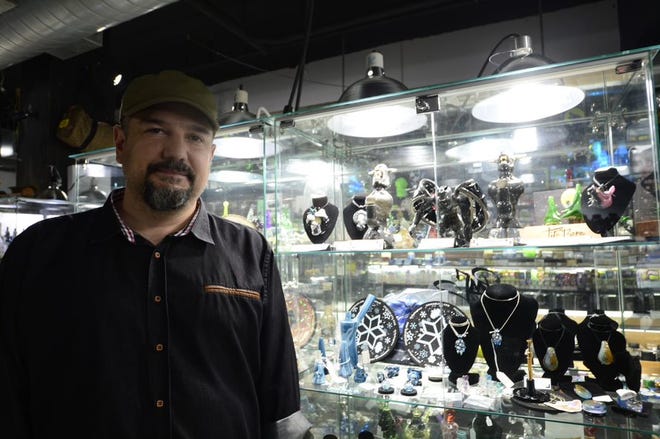
Bern's feeling overall is that artists have a more elevated platform now, and the industry melting pot is swelling with new faces.
Take Jess Baer, a ceramist with her own studio in Central Massachusetts. Baer saw recreational legalization in her state in 2016, with sales beginning in 2018, as an opportunity to expand her work. Along with tea cups and other home goods, she now sells ceramic, hand-glazed pipes, which she designs with her husband.
"Our vision was that we want our pipe to be on display in (modern home store) West Elm in 10 years," she said.
Others have glassmaking as part of their family lineage. Dave Buechner, who sells as Beak Glass in Portland, Maine, is a third-generation glass enthusiast. His parents opened Vitrix Hot Glass in Corning, New York in the late '70s, and his grandfather was the first director of the Corning Museum of Glass. His uncle currently owns Thames Glass in Newport, Rhode Island.
"I kind of grew up running around a hot shop as a kid," said Buechner, who decided to leave college to pursue the art and today does it full-time.
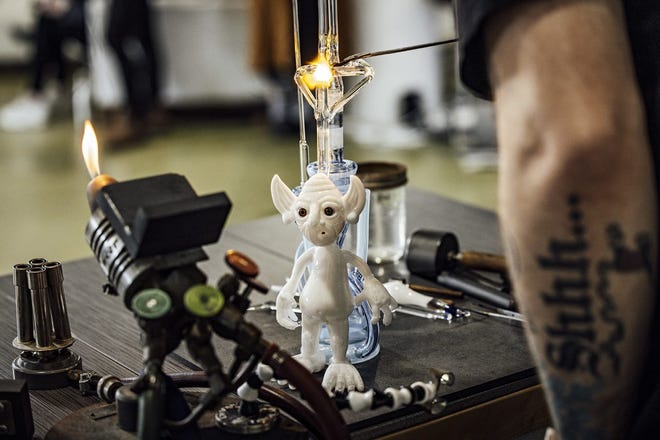
How legalization has impacted the marijuana glass business
It's typical when a trend or movement hits the "mainstream" that many jump on the bandwagon in the hopes of profit. Has this been the case for the marijuana industry, and specifically, its associated artists?
"Budweiser is making billions of gallons of beer, but that doesn't necessarily hurt the craft beer market, because people know what they're buying," said Vela.
The same goes for marijuana pipes.
Artisan glassmaking has remained standing on its own because of a loyal following – but like any business, there are challenges.
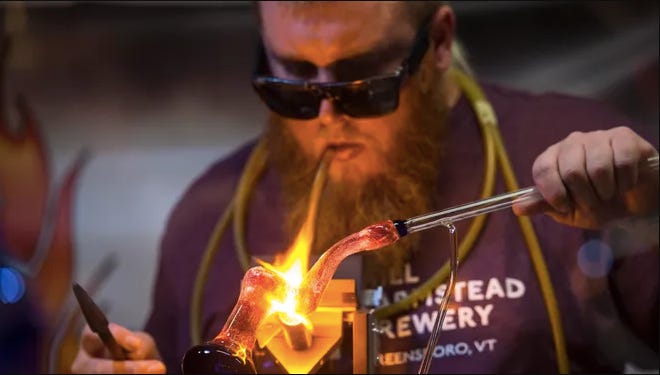
Vape pens 'a killer to glass pipes'
The growing popularity of marijuana vape pens has resulted in more and more people buying oil cartridges instead of marijuana flower, and therefore, fewer glass pieces. The vape pen market has been one of the fastest growing sectors of the cannabis industry.
"Legalization is actually happening, and it looks like the majority of people are turning to these devices," said Bern. "Such a killer to glass pipes."
The mass-production of glass pipes in other countries, particularly China, ramped up many years ago. Glass pieces imported from overseas are typically more affordable – often found in gas stations, convenience stores and college town head shops.
"A small glass pipe that I, as an American artist, would sell for $25 was now being sold by an import company out of China or Nepal for about $1.50," said Bern.
That dollar difference, though, hasn't overly impacted the American artisans who've gained an audience for their unique pieces that are usually one-of-a-kind collectibles, he said.
"A lot of these (artists) will have six-, eight-month, two-year wait lists to get on their wholesale order lists," said Tony Oliver, product manager for Sweet Dirt, a Maine cannabis company that sources from local makers. "It's great that they're that busy."
Portland, Maine's Buechner does mainly wholesale, and he said the start of recreational sales in the fall of 2020 resulted in a barrage of shops wanting to order glass.
"I've been the busiest I've ever been for the last year, I would say," said Buechner. "I think the smoking tourism thing is definitely a part of it. People aren't coming just to see the ocean and to hike. You can buy weed in a store here. A lot of tourists like to buy souvenirs and say they bought from a local Maine artist."
Buechner said the foreign import industry isn't as "scary" anymore, "because I make pipes that take a lot of skill to make." In Maine particularly, he said, there's a lot of pride in supporting local.
In Burlington, Vermont, the pipemaking scene is unique, in that the community had "already completely adopted cannabis in every way" before legalization was on the horizon, Bern said. He's had a devoted and interested clientele for years.
In that sense, legalization didn't change much for his business.
"This was happening independently long before legalization or when cannabis started hitting the mainstream," said Bern. "It was going to be here if people were feeding money into it or not."
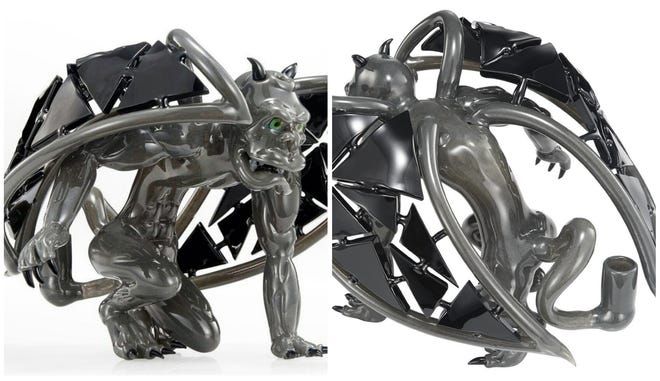
Growing comfort around marijuana, paraphernalia
Legalization impacts vary from place-to-place. For communities where marijuana use has long been stigmatized and disproportionately criminalized, legalization can represent a lot.
Communities of color have historically been unequally impacted by marijuana enforcement, including arrests for paraphernalia. As part of Vela's "Art of Glass" partnership with Calyx Containers and well-known glass artist Mike Shelbo, they'll raise money for nonprofits that support communities impacted by judicial cannabis inequities.
"I think fear is a really strong factor," said Vela. "As states legalize, it really just opens up opportunities to feel comfortable around (paraphernalia). People are more prone to just looking at it for what it is, which is a beautiful piece of art."
For Baer, the newfound comfortability around cannabis posed an opportunity to dip her toes in the water. She owns a ceramics studio in Worcester, Massachusetts, where she primarily makes home goods.
Her modern-looking ceramic pipes were born out of "conversations and beers around the coffee table" with her husband Zach Hastings, who is an industrial designer.
"It's one thing going through a craft fair and seeing 'it's wine-o-clock' wine glasses, and it's another having a ceramic pipe on your table," laughed Baer. Despite some initial hesitancy, she took the leap last year and started churning out minimalist pipes glazed in charcoal, baby pink, eggshell and speckled designs.
"It's been legalized, it's becoming less taboo," she said. "People aren't hiding their paraphernalia in their bedside tables anymore. Whole entire families are finding out that they all smoke. We're in this moment of time."
Creating a culture in Connecticut
Connecticut is less than a month into legalization, so it's "a little bit too soon" to tell how the new reality will impact business, said Charlie Ronemus, co-owner of Stoked in Bridgeport. But even in the months leading up, as it became more and more evident it was going to happen, Stoked started seeing some shifts in clientele.
"People coming in with their parents and grandparents," Ronemus said. "People are being more open about it and there's less stigma around the whole situation."
Stoked was recently named "smoke shop of the year" by Glass Vegas trade show. In addition to sourcing mostly American-made pieces, Stoked provides studio space for seven resident glassblowers.
"We just always wanted to envelope the retail sales with the experience of learning and seeing the art being made," said Ronemus. "It's helped us really create a culture, a scene here in Connecticut that didn't exist before."
420 Intel is Your Source for Marijuana News
420 Intel Canada is your leading news source for the Canadian cannabis industry. Get the latest updates on Canadian cannabis stocks and developments on how Canada continues to be a major player in the worldwide recreational and medical cannabis industry.
420 Intel Canada is the Canadian Industry news outlet that will keep you updated on how these Canadian developments in recreational and medical marijuana will impact the country and the world. Our commitment is to bring you the most important cannabis news stories from across Canada every day of the week.
Marijuana industry news is a constant endeavor with new developments each day. For marijuana news across the True North, 420 Intel Canada promises to bring you quality, Canadian, cannabis industry news.
You can get 420 Intel news delivered directly to your inbox by signing up for our daily marijuana news, ensuring you’re always kept up to date on the ever-changing cannabis industry. To stay even better informed about marijuana legalization news follow us on Twitter, Facebook and LinkedIn.




